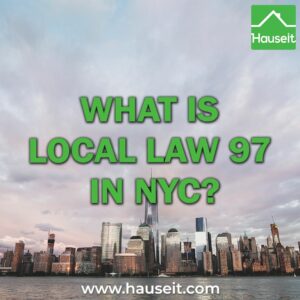Local Law 97 in NYC requires most large buildings over 25,000 square feet to meet new greenhouse gas emissions limits by 2024 as well as stricter limits which take effect in 2030.
From 2050 onward, a zero emissions requirement applies to all property types.
The goal of Local Law 97 is to facilitate the city’s broader efforts to combat climate change by achieving a 40% reduction in greenhouse gas emissions from covered buildings by 2030 from a 2005 baseline and an 80% reduction by 2050.
Buildings currently account for approximately two-thirds of greenhouse gas emissions in New York City, according to the NYC DOB.
Local Law 97 applies to most buildings over 25,000 square feet. This includes new and existing residential and non-residential buildings, such as condos and co-ops as well as office buildings.

Approximately 40,000 NYC buildings are covered under Local Law 97.
Local Law 97 also covers the following special cases:
-
Two or more buildings on the same tax lot that together exceed 50,000 square feet
-
Two or more buildings owned by a condo association that are governed by the same board of managers and that together exceed 50,000 square feet
Local Law 97 sets emission intensity limits (metric tons of CO2e per square foot) for 10 building categories based on Building Code occupancy groups which grow progressively stricter over time.
Buildings must meet specific emission reduction targets by 2024, 2029, and 2034. Buildings can meet these targets through a variety of measures, such as switching to cleaner fuel sources, improving building insulation and installing more efficient mechanicals.
Building owners may offset up to 100% of annual building emission limits by purchasing renewable energy credits (RECs) for local green power.
RECs must originate from a source which is “located in, or whose output directly sinks into” NYC’s electric grid zone.
From 2024 through 2029, building owners may offset up to 10% of annual building emissions by purchasing greenhouse gas offsets. These have no geographic limitation.
Building owners must file an annual Greenhouse Gas Emission report by May 1, 2025 and by May 1 of every year thereafter. The report must be certified by a registered design professional.
The Department of Buildings plans on releasing a tool allowing building owners to file for compliance.
From 2025 onward, buildings that exceed emission targets, fail to file a report or make a false statement are subject to fines. The fine categories and amounts are as follows:
-
Failure to file a report: $0.50 per building square foot, per month
-
Exceeding emissions limit: $268 for each metric ton over the building’s limit
-
False statement: $500 fine and also a misdemeanor
Local Law 97 is one of several measures that the city has implemented to reduce greenhouse gas emissions and achieve its goal of carbon neutrality by 2050.
Local Law 97 was passed by the New York City Council in April 2019 as part of the Climate Mobilization Act. The law went into effect on November 15, 2019.
Local Law 97 comprises Article 320 and Article 321. Article 320 establishes Building Energy and Emissions Limits for buildings starting in 2024 and outlines the implementation of such limits Article 321 establishes Energy Conservation Requirements for Certain Buildings that are not covered under Article 320. The original legislation text is accessible here.
Local Law 97 of 2019 was amended by Local Law 147 of 2019. There have also been a series of subsequent amendments.
What buildings are subject to Local Law 97?
Local Law 97 applies to most buildings over 25,000 square feet. Local Law 97 also applies to two or more buildings on the same tax lot that together exceed 50,000 square feet.
Two or more condominium buildings governed by the same board of managers and that together exceed 50,000 square feet are also covered by Local Law 97.
A Full Service Listing for 1%
Sell your home with a traditional full service listing for just one percent commission.
What buildings are exempt from Local Law 97?
Several types of large buildings are exempt from Local Law 97 under Article 320.
These consist of industrial buildings that primarily produce electrical power or steam and detached or semi-detached buildings of three stories or less, where each owner owns and maintains their own HVAC and hot water systems that serve spaces of 25,000 square feet or less.
In addition, some covered buildings are allowed to use alternative compliance pathways for complying with Local Law 97. These include the following:
-
An industrial facility primarily used for the generation of electric power or steam.
-
Real property, not more than three stories, consisting of a series of attached, detached or semi-detached dwellings, for which ownership and the responsibility for maintenance of the HVAC systems and hot water heating systems is held by each individual dwelling unit owner, and with no HVAC system or hot water heating system in the series serving more than 25,000 gross square feet, as certified by a registered design professional to the department.
-
A city building.
-
A housing development or building on land owned by the New York city housing authority
-
A rent regulated accommodation.
-
A building whose main use or dominant occupancy is classified as occupancy group A-3 religious house of worship.
-
Real property owned by a housing development fund company organized pursuant to the business corporation law and article eleven of the private housing finance law.
-
A building that participates in a project-based federal housing program.
Not-for-profit hospitals and healthcare facilities may apply for an emission percentage reduction requirement instead of a cap.
For calendar years 2024 through 2029, qualifying facilities must reduce emissions by 15% relative to 2018 levels.
For calendar years 2030 through 2034, qualifying facilities are required to lower emissions by 30% relative to 2018 levels.
What financing options exist for Local Law 97 compliance?
The City Council established a loan program called Property Assessed Clean Energy (PACE) financing under Local Law 96 to help building owners pay for the costly retrofits needed to comply with Local Law 97.
PACE loans provide up to 100% financing for qualifying projects with low interest rates and longer terms. They are repaid through a building’s property tax bill.
Building owners may apply for PACE loans to fund any number of energy efficiency and clean energy technologies. These include:
-
Building Enclosure
-
HVAC and Controls
-
Lighting
-
Domestic Hot Water
-
Demand Response
-
Energy Storage
-
Solar Photovoltaic
-
Combined Heat and Power
-
Fuel Conversion
-
Deep Energy Retrofits
-
High-Performance Buildings
-
Other technologies and applications evaluated on a case-by-case basis






